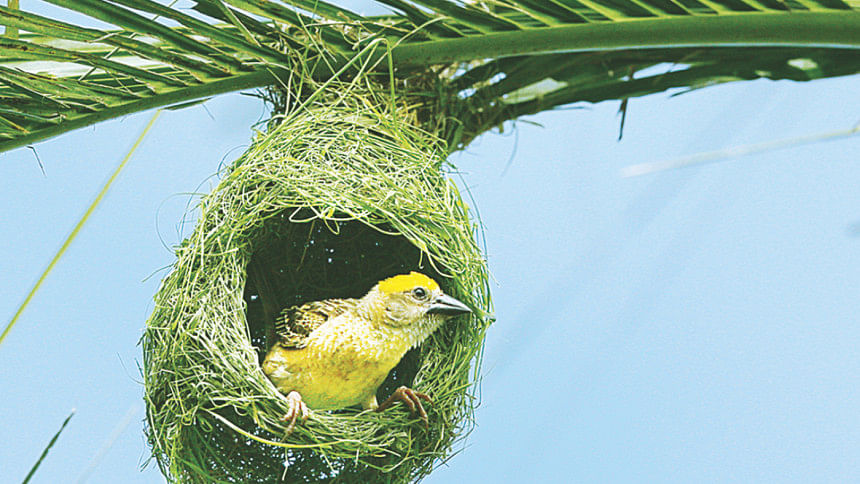The Babui's House

Then I was growing up the story of the babui – or baya weaver – was popular in school textbooks. Usually there was an essay describing the bird's amazing ability to weave nests. On the side was a drawing of the elongated nest, hanging from a tree. I saw many such nests as a child, hanging mostly from taal palms, but scarcely gave them a second glance.
As an adult I take much more interest in birds than I did as a child. Babuis are not as plentiful as they once were, but I see them occasionally in the countryside, moving in flocks. It is easy to confuse them with the house sparrow, but they are generally lighter in colour and smaller. Their nests, however, proved elusive.
I finally found babui nests in Moulvi Bazar's Hail Haor. It was a hot summer afternoon. The recent rains had rendered the unpaved road unfit for car, so I was walking. Well inside the haor, I heard the cacophony of a group of birds and tracked them to a row of nine tall shupari trees. About a hundred nests were hanging from the fronds of the trees.
It was an astonishing sight: hundreds of babui birds frantically working on the nests which were gently blowing in the warm summer breeze against a deep blue sky.
I watched the birds at work. If you have ever played with shupari leaves, you know they are hard to tear laterally but can be easily stripped into thin threads along their length. That's exactly what the nest-building babui did. It tore each palm leaf into thin long threads, one thread at a time, using its bill as the scissor. Then, holding the thread in its bill, it flew very fast to its nest. Using its bill as a needle, it wove the thread in and out, adding another layer to the nest.
The birds moved quickly, making it difficult to follow their action. But once I had grown accustomed to the pattern, I discovered something that magnified my respect for their ability. Every time a bird had woven in a thread, it tested the result of its work. How? If it had worked on the outside wall, it pressed and nudged with its bill and body to make sure the nest was strong. If it had worked inside, it went in and flexed its wings against the wall to make sure it did not break.
There were two types of nests. One is with a closed bottom, like a ball, which the mother uses for laying eggs and incubating. The other has an open bottom and a bar running across it. It purpose seemed more for perching and relaxing.
The nests are built by male birds, identified by the bright yellow crown on their head. While making the nests, they usually display for the females. A female then chooses a nest, and completes it by adding soft finishing. It mates with the owner of the nest. Then it lays the eggs and incubates them.
There are many species of weaver birds around the world. Bangladesh has three species of them. It was a revelation to watch our babuis at work. They are gifted engineers.
facebook.com/tangents.ikabir

 For all latest news, follow The Daily Star's Google News channel.
For all latest news, follow The Daily Star's Google News channel. 



Comments